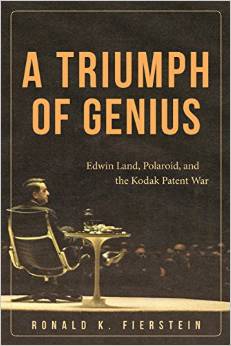 For more than two centuries, the U.S. patent system has bumped along, imperfect and the subject of anger and frustration on the part of patent infringers and patent owners alike, but still capable of producing geniuses like the Wright Brothers, Thomas Edison and scores of inventions that changed the world.
For more than two centuries, the U.S. patent system has bumped along, imperfect and the subject of anger and frustration on the part of patent infringers and patent owners alike, but still capable of producing geniuses like the Wright Brothers, Thomas Edison and scores of inventions that changed the world.
Polaroid v. Kodak, concluded in 1991 after 15 years, was the first “billion dollar” patent damages award ($909 million), and, until this year, the largest satisfied judgment in a patent case awarded by a U.S. court. In current value, the award would be almost $2 billion. It was the case that launched 10,000 patent suits, many by non-practicing entities.
The Polaroid dispute involved patents covering instant photography, which at the time was among the most valuable technologies. But as one observer pointed out, by the end of the long dispute, the Polaroid-Kodak battle was “little more than two aging giants dueling on the decks of the Titanic.” Digital photography would soon eclipse instant photography, and both litigants were on the road to insolvency.
Polaroid, which once had 27,000 employees, filed for bankruptcy twice, once in 2001 and then again in 2008 (aka “Chapter 22”), and Kodak, which boasted 147,000 workers at its peak, filed in 2012. It was too little too late to save these once great businesses.
Polaroid and Kodak were the standard-bearers of quality in their respective fields — instant photography, inexpensive cameras and photographic film. Kodachrome was the go-to brand among both professional and amateur photographers for decades, unsurpassed for sharpness and color saturation. Both companies were guilty of focusing too keenly on protecting the formidable and highly profitable products they had and not on those that were to emerge.
Both took their eyes off the horizon or, perhaps, it was the rear view mirror. In the end, digital photography championed by Sony and other Asian conglomerates, did-in both companies, whose products were once as ubiquitous in households throughout the developed world as those of Apple and Google today.
*****
A Triumph of Genius: Edwin Land, Polaroid, and the Kodak Patent War is a timely book about an infamous case, a bold inventor, two innovative companies that lost their mojo, and a technology at the apex of its popularity. The book comes at a time when the patent system is being improved to the point of extinction and significant damages awards are virtually impossible to obtain. Written by Ronald K. Fierstein, one of the lawyers in the case, A Triumph of Genius is also a triumph of superb non-fiction writing.
When a review copy landed on my desk recently, I was not keen on opening it. Did I really have to read this book about a 25-year-old case, all 672 pages of it? Yet A Triumph of Genius hooked me from page one. It is a compelling story, expertly told. Fierstein’s deft prose and you-are-there perspective captures all of the drama of high stakes litigation and the personalities that fuel it. This book is required reading for anyone affected by innovation or IP rights, or who has been involved in a business dispute. It is also useful for investors who want to understand the complex mechanics of a patent suit and the arduous march to trial and slog through the appeals process. The book is often too good to put down, if unwieldy to carry. I simply downloaded the digital edition for about $8.00 and read it over a period of days. (Hardcover and recorded versions also are available.)
The “triumph” in the title can be understood in at least three different ways: the victory of Edwin Land, the inventor of instant photography and Polaroid’s founder and leader; Polaroid’s patents covering breakthrough inventions, which were upheld; or the patent system itself, which permitted an infringed rights holder to prevail. The case was litigated at a time when inventions were more respected, and honor as much as money was at stake. The Court of Appeals for the Federal Circuit (CAFC) established in 1982 made enforcing patents easier. The timing was right for a huge trial win and damages award, and Polaroid seized the day.
Polaroid v. Kodak is a classic because of the invention and companies involved, and the amount of damages, but also because of the personalities, especially the reclusive Mr. Land, whose grandparents fled Russia for a better life in America, and who dropped out of college. Two of the most venerable law firms led the fight: Fish & Neave (of which Fierstein was then a junior member) and Kenyon & Kenyon, the oldest and one of the largest IP firms. Fish & Neave merged into Ropes & Gray in 2006 and Kenyon, I am glad to say, is still a leading IP boutique.
*****
On a personal note, Polaroid’s victory, more precisely Kodak’s loss, helped to launch my own IP career. In 1989, with Kodak about to conclude the damages phase of the case, Kenyon & Kenyon retained the newly formed Brody Berman Associates to help convey it was very much alive and well. To Kenyon’s credit, despite Polaroids’s repeated attempts, it was unable to establish willful infringement, saving Kodak hundreds of millions and possibly billions of dollars. A new era of patent damages awards would rage for the next two decades and firms like Kenyon were well-equipped to defend business against them. “The $909-million award was far short of the $2.5 billion that some Wall Street analysts had expected,” wrote the Los Angeles Times, “or the $5.7 billion in lost profits and interest that Polaroid had demanded in court papers it filed.”
Edwin Land was a unique if obsessive genius, who created elegant, even magical products and built a modern corporate culture that combined academic and business initiatives. His ideals were emulated by Apple in its products and style. Steve Jobs called him “a national treasure.” When Land died in 1991, he was the third most prolific inventor by patent count, behind Edison and Edison associate Elihu Thomson. Life called Land one of the most important American’s of the 20th Century. Like Bill Gates, Mark Zuckerberg and Robert Frost before him, Land was a Harvard dropout.
“It should be the role of our patent system to bring encouragement,” Land had proclaimed in 1959, “a sense of reward, and a stimulus to prompt publication to this potential army of great researchers.”
Kodak had achieved much since its founding in 1880 and conducted abundant R&D. It was incredulous that it was being accused of patent infringement. From its inception, Kodak dominated American photography. As late as 1976, the company commanded 90% of film sales and 85% of camera sales in the U.S., according to a 2005 case study for Harvard Business School. By 1988, Kodak was the fifth most valuable brand in the world.
*****
Ron Fierstein was not a good enough guitarist to fulfill his dream of becoming a rock star. The Brooklyn-born attorney left patent law in the 1990 and went into entertainment management, representing such acts as Susan Vega, best known for hit song, “Tom’s Diner.” Fierstein also co-produced the successful Broadway musical “Kinky Boots” with his famous brother, Harvey. I have never met Fierstein, but he and his family reside in the next village from mine in Westchester County just north of Manhattan. I’ve probably sat next to him on the train without realizing it.
The takeaway from this encouraging but sad case and transformative book is that no matter how great we think an invention is, no matter how de facto a standard a company appears to have established, nothing is forever. All things must pass. There is always something somewhere waiting in the wings to improve on perfection. If not, there should be. “Land had emphatically proclaimed the critical importance of the patent system to realizing fully the contribution of the small technology company and the individual inventor to mankind’s evolving body of knowledge and understanding,” writes Fierstein.
The popularity of the products associated with Polaroid and Kodak could not insulate them from obsolescence. Patent infringement battles like Polaroid v. Kodak, may not appear to lead to anything meaningful, but they are a necessary part of the inventive process and technological evolution. A Triumph of Genius brilliantly illustrates that timing is everything. The patent pendulum whose momentum propelled the patent holder two decades ago has swung in favor of the defendant. The immediate impact is likely to produce fewer, if any, Polaroid-size victories in the near-term, not necessarily a bad thing. The longer-term impact on innovation and commerce, however, is less clear. The funny thing about great inventions and successful businesses: no matter how good they are in their time, they eventually make way for newer ones.

![[IPWatchdog Logo]](https://ipwatchdog.com/wp-content/themes/IPWatchdog%20-%202023/assets/images/temp/logo-small@2x.png)

![[Advertisement]](https://ipwatchdog.com/wp-content/uploads/2024/04/UnitedLex-May-2-2024-sidebar-700x500-1.jpg)
![[Advertisement]](https://ipwatchdog.com/wp-content/uploads/2024/04/Artificial-Intelligence-2024-REPLAY-sidebar-700x500-corrected.jpg)
![[Advertisement]](https://ipwatchdog.com/wp-content/uploads/2024/04/Patent-Litigation-Masters-2024-sidebar-700x500-1.jpg)

![[Advertisement]](https://ipwatchdog.com/wp-content/uploads/2021/12/WEBINAR-336-x-280-px.png)
![[Advertisement]](https://ipwatchdog.com/wp-content/uploads/2021/12/2021-Patent-Practice-on-Demand-recorded-Feb-2021-336-x-280.jpg)
![[Advertisement]](https://ipwatchdog.com/wp-content/uploads/2021/12/Ad-4-The-Invent-Patent-System™.png)






Join the Discussion
4 comments so far.
Paul F, Morgan
August 24, 2015 11:29 amIs this still the largest infringement damages award that was actually paid, especially when converted to present dollars? That amount paid was just short of one billion dollars because the interest accruing on the judgement if paid any later would soon have pushed it over one billion.
I am curious if the author of this book noted my jointly authored JPTOS article documenting one of the several Kodak miss-calculations? “Probabilities of Losing As To At Least One Patent In Multi-Patent Litigation,” Journal of the Patent and Trademark Office Society (JPTOS), October 1986, Vol. 68, No. 10, pp. 498-502.” [I later obtained informal
confirmations of that lack of consideration.]
EG
August 24, 2015 08:11 amHey Bruce,
I was in practice as a patent attorney at Procter and Gamble when the Polaroid v. Kodak judgment of came out in the 1980’s and I can tell you more than the patent attorneys really took notice of how big this judgment was, especially the media. Also, to get to the “$1 billion” mark, it should be noted that the base damage judgment was trebled because Kodak was deemed to have “willfully infringed.” Again, you’re spot on that this case really put patents on the map, following the horrific 1960’s and 1970’s where the Royal Nine (like they’re again doing now) greatly devalued the worth of patents, and more importantly, impeded a primary incentive for innovation.
Bruce Berman
August 23, 2015 04:40 pmIt’s truly a great read and a timely one.
EG
August 23, 2015 08:33 amHey Bruce,
A nice piece and reminder not only about the first “$1 billion” patent infringement case, but also the danger of being complacent about your technology portfolio. And this book needs to be on my “wish list”!